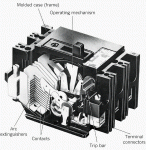I have a 1976 vintage circuit breaker that arced to ground vis the operator that contacts the bottom side of the toggle/handle. This occurred when the steel rotary door mounted operator was rotated to turn the breaker on. It appears the toggle/lever was cracked. I didn't realize the middle phase was located in the toggle/lever. Is this common in CB construction? Its a molded plastic frame. Maybe even bake-lite... Thanks for any feedback
It’s not Bakelite. That’s a composite of resin and paper used before the 1960s. Operators of some kind strapped to a molded case circuit breaker are used in modern designs too.
The thing though is breakers are consumables. They have a limited life. Yours either failed already or this was the last cycle. The failure you are describing is pretty common when the contacts burn up and metal vapor either ejects out the vents if it has some or out the back if it doesn’t, often leading to a ground fault and tripping the upstream breaker.
Every molded case breaker, even one that old, refers to NEMA AB4. You can download this standard for free and I’d encourage you to do it.
It tells you to visually inspect your breakers once a year and after every trip. It takes about a minute to do it properly and NEMA AB4 has nice instructions and color pictures telling you exactly what to look for. That’s why you should download it.
Story time. This happened around 2000-2002, before most people ever heard of 70E. A local electrician in coastal NC worked at a large mine. A 3 phase 10 HP sump pump tripped the breaker (actually an MCP). The operator reset it “several times” then called the electrician. The electrician did the same thing a couple times before finally meggering the motor, which was dead shorted. So they changed out the motor. When the electrician went to remove his lock and close the breaker to put it back in service, the breaker exploded. Since it was on a 2500 kVA transformer with very slow upstream protection, it sent him off to the burn unit at Duke University Hospital. There is still a huge burn mark about 10 feet wide all over one wall and ceiling where it happened.
Because he didn’t open the door and take 60 seconds to look it over before putting it back in service, never mind the stress he and the operator put it through hitting it with near AIC rated current multiple times in a row.
In the same facility as we did a big upgrade we changed out about a half dozen 1970s vintage breakers based on AB4 inspections. I tested them just because of politics and they all failed standard breaker testing. One blew in half. One had one phase work, another welded shut, and a third burned open, on the same breaker! AB4 works and will save you headaches.



